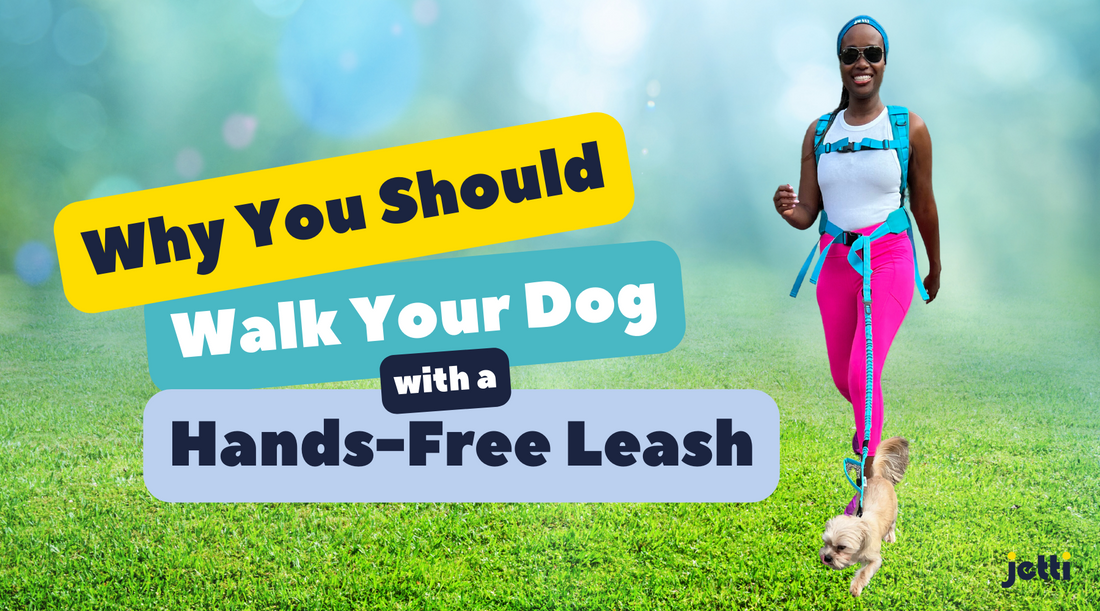When I’m out for a walk, I don’t like to have anything in my hands. Not my phone, or a water bottle, or even my dog, Moose’s, leash. I’ve realized that carrying something throws off my natural gait and makes walking feel less comfortable and less “free.” Sure, I can place my phone in a pocket and get a fitness belt that holds a small water bottle, but what can I do to keep my dog safe without affecting my gait? I can use a hands-free leash.
Why holding a leash affects your gait
To understand what’s going on when I’m holding Moose’s leash in my hand, I consulted Sarah Zahab, a Registered Kinesiologist, Clinical Exercise Physiologist, co-founder of Continuum Fitness & Movement Performance and a nationally-ranked, champion racewalker. Sarah is also a dog owner who understands first-hand how walking your dog on leash can impact your gait.
“I spent several months training my puppy to walk loosely (meaning there is slack with no pulling) on a leash,” Sarah told me, “because walking a dog on leash can really alter gait mechanics and lead to potential discomforts or repetitive injuries. Even with a well-trained dog who walks loosely on a leash, I still find my gait is not the same as without a leash.”
Sarah went on to help explain how holding a leash can affect your walking gait.
Alterations in arm swing
Holding a leash requires you to keep one or both hands engaged, which can affect your natural arm swing while you walk. Even though the difference might be slight, it can be enough to limit the freedom of movement in your arms resulting in a change to your gait pattern.
Sarah explains holding a leash prevents you from fully driving the arm holding the leash back, and that backwards arm drive allows for more forward momentum. “This shift will lead to the asymmetries,” she said.
Asymmetry
Most people typically hold their dog’s leash in the same hand, encouraging them to walk on the same side (typically, on the left in the U.S.). Consistently holding the leash in one hand can create an asymmetrical pattern in your gait, which, over time, may affect your body's alignment, potentially impacting the muscles and joints on one side of your body more than the other.
In addition, when a dog pulls on the leash, Sarah explains that adds rotational forces, causing more thoracic and possibly lumbo-pelvic rotation to one side which may challenge the pelvis and thoracic spine.
“I know of many individuals who complain of one-sided shoulder, back, sacroiliac joint and pelvic pain when being pulled by a dog,” said Sarah. The pulling may also cause the walker to spend more time on one leg versus the other which can also cause potential issues.”
Interference with the cross-crawl nature of walking
Walking is a fundamental cross-crawl movement, one in which you are coordinating movements of the opposite sides of your body. Typically, your right arm moves in opposition to your left leg, and vice versa. These kinds of movements have been shown to simultaneously activate the right and left sides of your brain, strengthening those connections. Walking while holding a leash seems, at least to me, to interfere with this rhythm.
Leash impact depends on the dog and owner
Sarah is quick to point out that the impact of holding a leash depends on both you and your pup. “For healthy people who have higher capacities in general, it might not be a big issue, while individuals with lower thresholds and dogs that pull aggressively may find themselves in a bit of hot water.”
Walking with a hands-free leash
One way to minimize these potential impacts is to use a hands-free leash. For a well-behaved dog, a hands-free leash can enable you to maintain your natural gait and give you both a bit more walking freedom.
Hands-free leashes still keep your pup secure while allowing them the chance to walk with a loose lead. In some hands-free leashes, they even include a “traffic handle,” which you can easily grab to keep your furry friend close when needed, and a built-in bungee that reduces the jolt on the dog if they do decide to wander too far.
Dogs truly are one of the best walking companions. It’s obvious from their smile that they share your joy of getting outside and being in nature. And there’s no better way to capture that joy than snapping a quick photo while on your next walk since your hands, well, they’ll be free.



